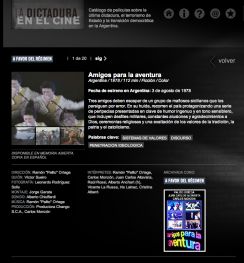By Nayana Fernandez for LAB
 Memoria Abierta is a group of five Argentinian organisations that looks for ways to advance truth, justice and memory and to repair the damage to individuals and society caused by State terrorism. One of its main objectives is to make accessible all documentation relating to the last military dictatorship for purposes of research and the education of future generations. They identify, computerise, produce and catalogue written articles, images, testimonies, audio-visual material, drawings, maps and objects and have established an archive open to the public. They also coordinate with the work of human rights organisations to raise social awareness and knowledge about state terrorism as a means of enriching and safeguarding the culture of democracy. One of their most remarkable projects is a Catalogue, “La Dictadura en el Cine” (Dictatorship on the Big Screen) launched in 2001 with 440 films about the last dictatorship, State terrorism and the democratic transition in Argentina. It can be accessed here. (http://www.memoriaabierta.org.ar/ladictaduraenelcine/index.html)
Memoria Abierta is a group of five Argentinian organisations that looks for ways to advance truth, justice and memory and to repair the damage to individuals and society caused by State terrorism. One of its main objectives is to make accessible all documentation relating to the last military dictatorship for purposes of research and the education of future generations. They identify, computerise, produce and catalogue written articles, images, testimonies, audio-visual material, drawings, maps and objects and have established an archive open to the public. They also coordinate with the work of human rights organisations to raise social awareness and knowledge about state terrorism as a means of enriching and safeguarding the culture of democracy. One of their most remarkable projects is a Catalogue, “La Dictadura en el Cine” (Dictatorship on the Big Screen) launched in 2001 with 440 films about the last dictatorship, State terrorism and the democratic transition in Argentina. It can be accessed here. (http://www.memoriaabierta.org.ar/ladictaduraenelcine/index.html)
While working on this catalogue, they discovered two censored films: “Estoy Herido” Ataque! (1977) and Frihetens murar, Murallas de la Libertad–Marianne Ahrne, 1978 [1]. Both films disappeared for many years, but today they are available for public viewing at Memoria Abierta’s headquarters in Buenos Aires.
Memoria Abierta’s website lists the 440 films by theme, alphabetically and chronologically – in Spanish only. Each film is displayed with all available production data, technical and format details, synopsis, credits, date premiered, stills and poster images. Memoria Abierta has also posted 94 videos on their YouTube channel with testimonies, panel discussions, trials, interviews and some films, including extracts from the two newly discovered ones.

